Chapter 18 Carboxylic Acid Derivatives Lecture 24 Chem

Chapter 18 Carboxylic Acid Derivatives Lecture 24 Chem 30 B

Carboxyl Derivatives • In this chapter, we study five classes of organic compounds. – Under the structural formula of each is a drawing to help you see its relationship to the carboxyl group.

Structure: Acid Chlorides • The functional group of an acid halide is an acyl group bonded to a halogen. – The most common are the acid chlorides. – To name, change the suffix -ic acid to -yl halide

Sulfonyl Chlorides – Replacement of -OH in a sulfonic acid by -Cl gives a sulfonyl chloride.

Acid Anhydrides • The functional group of an acid anhydride is two acyl groups bonded to an oxygen atom. – The anhydride may be symmetrical (two identical acyl groups) or mixed (two different acyl groups). – To name, replace acid of the parent acid by anhydride

Acid Anhydrides • Cyclic anhydrides are named from the dicarboxylic acids from which they are derived.

Phosphoric Anhydrides • A phosphoric anhydride contains two phosphoryl groups bonded to an oxygen atom.

Esters • The functional group of an ester is an acyl group bonded to -OR or -OAr. – Name the alkyl or aryl group bonded to oxygen followed by the name of the acid. – Change the suffix -ic acid to -ate

Esters • Lactone: Lactone A cyclic ester. – name the parent carboxylic acid, drop the suffix -ic acid and add -olactone

Esters of Phosphoric Acid • Phosphoric acid forms mono-, di-, and triesters. • Name by giving the name of the alkyl or aryl group(s) bonded to oxygen followed by the word phosphate • In more complex phosphoric esters, it is common to name the organic molecule and then indicate the presence of the phosphoric ester by the word phosphate or the prefix phospho-

Amides • IUPAC: drop -oic acid from the name of the parent acid and add -amide For the common name, drop -ic of the parent name and add -amide • if the amide nitrogen is bonded to an alkyl or aryl group, name the group and show its location on nitrogen by N-.

Amides • Lactams: A cyclic amides are called lactams. – Name the parent carboxylic acid, drop the suffix -ic acid and add -lactam

Penicillins – The penicillins are a family of -lactam antibiotics.

Cephalosporins – The cephalosporins are also -lactam antibiotics.

Imides • The functional group of an imide is two acyl groups bonded to nitrogen. – Both succinimide and phthalimide are cyclic imides.

Nitriles • The functional group of a nitrile is a cyano group – IUPAC names: name as an alkanenitrile – common names: drop the -ic acid and add onitrile

Acidity of N-H bonds • Amides are comparable in acidity to alcohols. – Water-insoluble amides do not react with Na. OH or other alkali metal hydroxides to form water-soluble salts. • Sulfonamides and imides are more acidic than amides.

Acidity of N-H bonds • Imides are more acidic than amides because 1. the electron-withdrawing inductive of the two adjacent C=O groups weakens the N-H bond 2. the imide anion is stabilized by resonance delocalization of the negative charge.

Acidity of N-H – Imides such as phthalimide readily dissolve in aqueous Na. OH as water-soluble salts.

Acidity of N-H • Saccharin, an artificial sweetener, is an imide. The imide is sufficiently acidic that it reacts with Na. OH and aqueous NH 3 to form water-soluble salts. The ammonium salt is used to make liquid Saccharin in solid form is the Ca 2+ salt.

Characteristic Reactions • Nucleophilic acyl substitution: An additionelimination sequence resulting in substitution of one nucleophile for another.

Characteristic Reactions – In the general reaction, we showed the leaving group as an anion to illustrate an important point about them: the weaker the base, the better the leaving group.

Characteristic Reactions – Halide ion is the weakest base and the best leaving group; acid halides are the most reactive toward nucleophilic acyl substitution. – Amide ion is the strongest base and the poorest leaving group; amides are the least reactive toward nucleophilic acyl substitution.

Reaction with H 2 O - Acid Chlorides – Low-molecular-weight acid chlorides react rapidly with water. – Higher molecular-weight acid chlorides are less soluble in water and react less readily.

Reaction with H 2 O - Anhydrides – Low-molecular-weight anhydrides react readily with water to give two molecules of carboxylic acid. – Higher-molecular-weight anhydrides also react with water, but less readily.

Reaction with H 2 O - Anhydrides – Step 1: Addition of H 2 O to give a TCAI.

Reaction with H 2 O - Anhydrides –Step 2: Protonation followed collapse of the TCAI.

Reaction with H 2 O - Esters • Esters are hydrolyzed only slowly, even in boiling water. – Hydrolysis becomes more rapid if they are heated with either aqueous acid or base. • Hydrolysis in aqueous acid is the reverse of Fischer esterification. – The role of the acid catalyst is to protonate the carbonyl oxygen and increase its electrophilic character toward attack by water (a weak nucleophile) to form a tetrahedral carbonyl addition intermediate. – Collapse of this intermediate gives the carboxylic acid and alcohol.

Reaction with H 2 O - Esters • Acid-catalyzed ester hydrolysis

Reaction with H 2 O - Esters • Saponification: Saponification The hydrolysis of an esters in aqueous base. – Each mole of ester hydrolyzed requires 1 mole of base – For this reason, ester hydrolysis in aqueous base is said to be base promoted. – Hydrolysis of an ester in aqueous base involves formation of a tetrahedral carbonyl addition intermediate followed by its collapse and proton transfer.

Reaction with H 2 O - Esters – Step 1: Attack of hydroxide ion (a nucleophile) on the carbonyl carbon (an electrophile). – Step 2: Collapse of the TCAI. – Step 3: Proton transfer to the alkoxide ion; this step is irreversible and drives saponification to completion.

Reaction with H 2 O - Amides • Hydrolysis of an amide in aqueous acid requires one mole of acid per mole of amide. – Reaction is driven to completion by the acidbase reaction between the amine or ammonia and the acid.

Reaction with H 2 O - Amides • Hydrolysis of an amide in aqueous base requires one mole of base per mole of amide. – Reaction is driven to completion by the irreversible formation of the carboxylate salt.

Reaction with H 2 O - Amides – Step 1: Protonation of the carbonyl oxygen gives a resonance-stabilized cation intermediate.

Reaction with H 2 O - Amides – Step 2: Addition of water to the carbonyl carbon followed by proton transfer gives a TCAI. – Step 3: Collapse of the TCAI and proton transfer.

Reaction with H 2 O - Nitriles • The cyano group is hydrolyzed in aqueous acid to a carboxyl group and ammonium ion. – Protonation of the cyano nitrogen gives a cation that reacts with water to give an imidic acid. – Keto-enol tautomerism gives the amide.

Reaction with H 2 O - Nitriles – Hydrolysis of a cyano group in aqueous base gives a carboxylic anion and ammonia; acidification converts the carboxylic anion to the carboxylic acid.

Reaction with H 2 O - Nitriles Hydrolysis of nitriles is a valuable route to carboxylic acids.
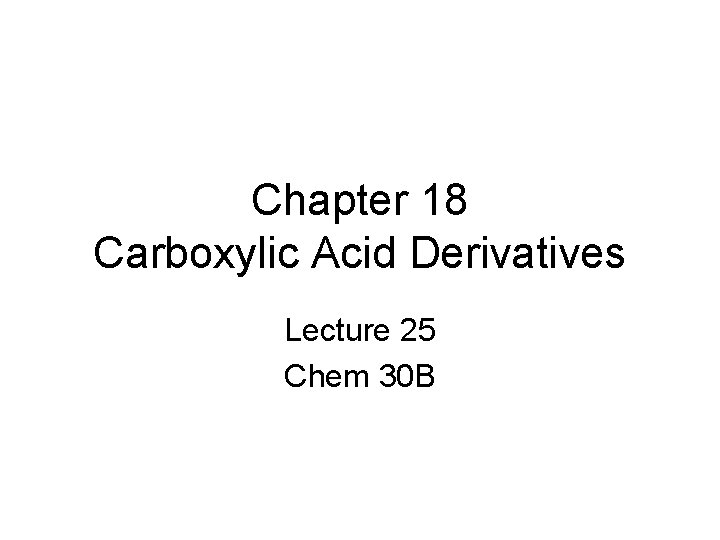
Chapter 18 Carboxylic Acid Derivatives Lecture 25 Chem 30 B

Reaction with Alcohols • Acid halides react with alcohols to give esters. – Acid halides are so reactive toward even weak nucleophiles such as alcohols that no catalyst is necessary. – If the alcohol or resulting ester is sensitive to HCl, the reaction is carried out in the presence of a 3° amine to neutralize the acid.
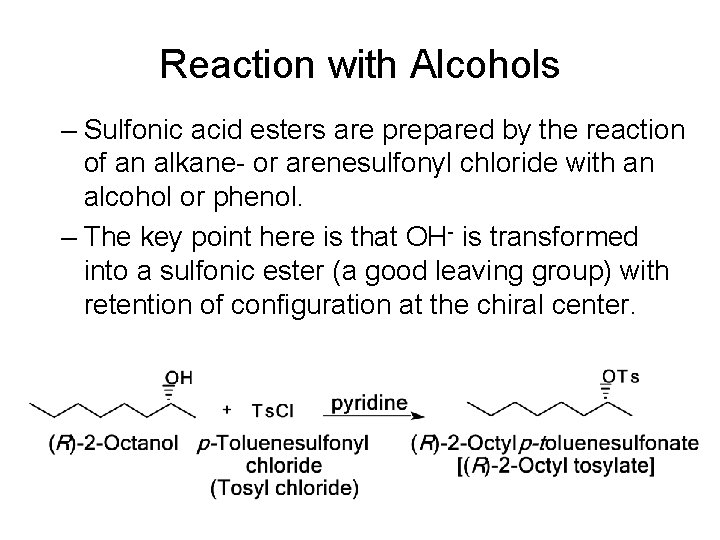
Reaction with Alcohols – Sulfonic acid esters are prepared by the reaction of an alkane- or arenesulfonyl chloride with an alcohol or phenol. – The key point here is that OH- is transformed into a sulfonic ester (a good leaving group) with retention of configuration at the chiral center.
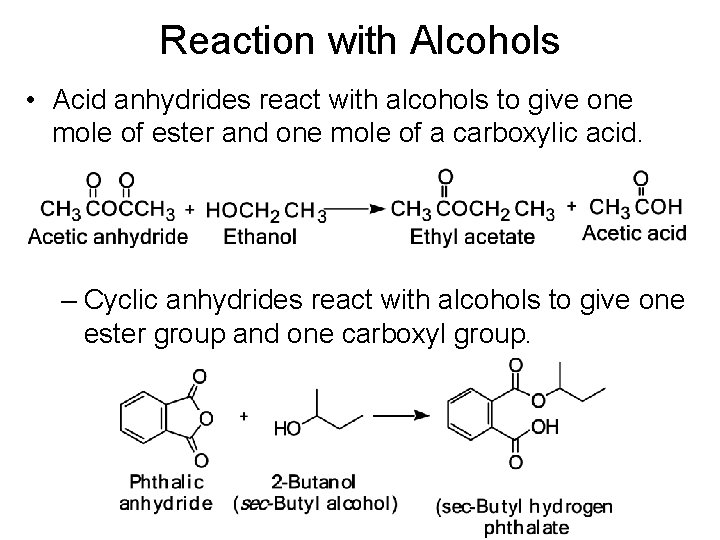
Reaction with Alcohols • Acid anhydrides react with alcohols to give one mole of ester and one mole of a carboxylic acid. – Cyclic anhydrides react with alcohols to give one ester group and one carboxyl group.
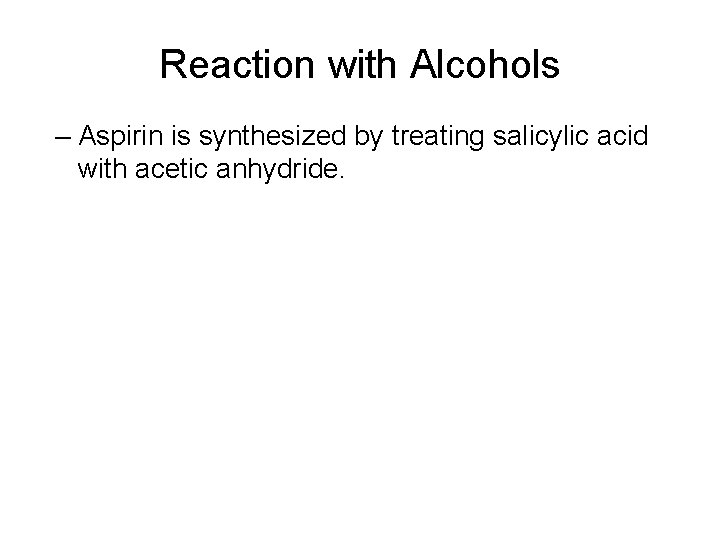
Reaction with Alcohols – Aspirin is synthesized by treating salicylic acid with acetic anhydride.
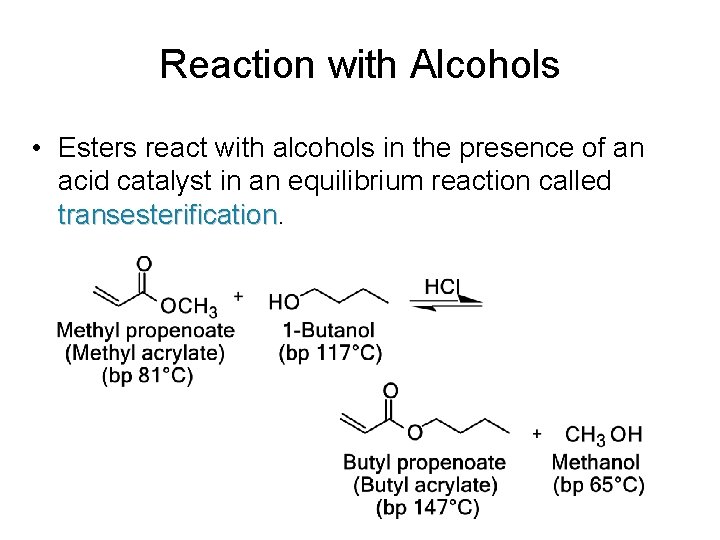
Reaction with Alcohols • Esters react with alcohols in the presence of an acid catalyst in an equilibrium reaction called transesterification
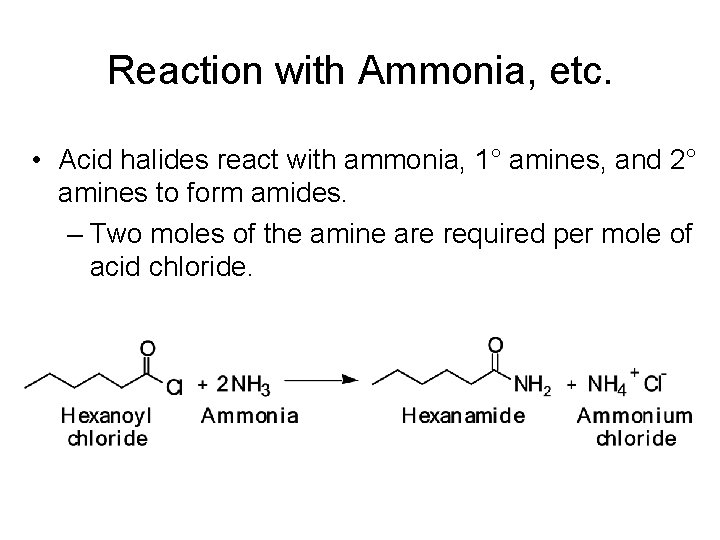
Reaction with Ammonia, etc. • Acid halides react with ammonia, 1° amines, and 2° amines to form amides. – Two moles of the amine are required per mole of acid chloride.
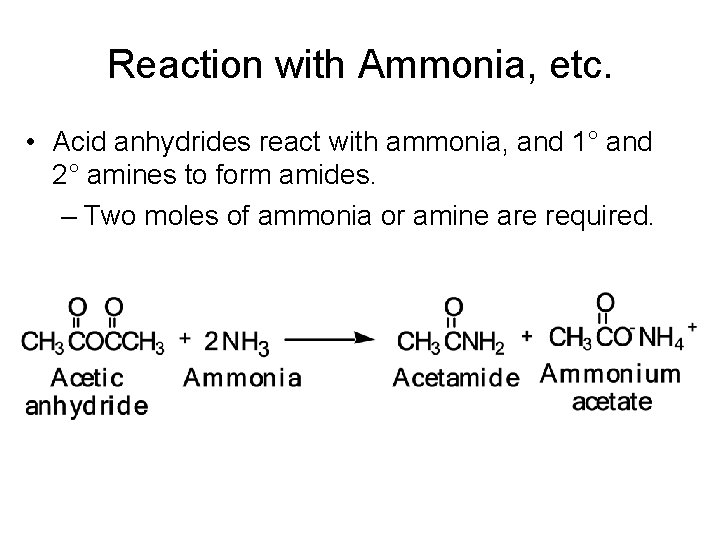
Reaction with Ammonia, etc. • Acid anhydrides react with ammonia, and 1° and 2° amines to form amides. – Two moles of ammonia or amine are required.
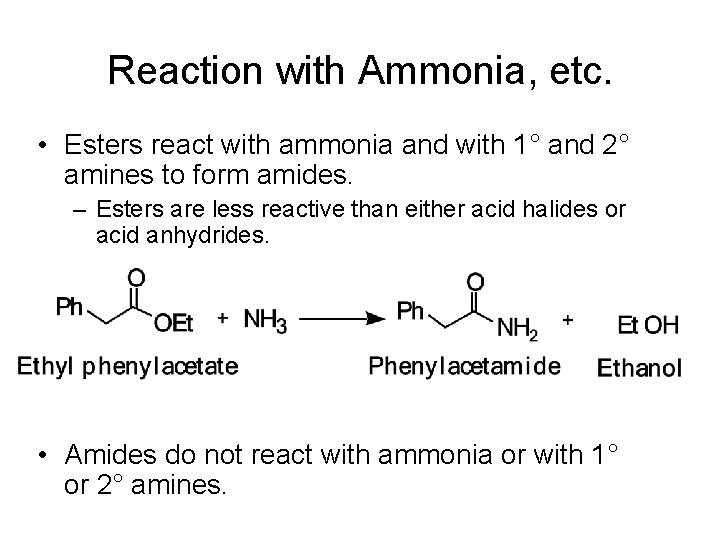
Reaction with Ammonia, etc. • Esters react with ammonia and with 1° and 2° amines to form amides. – Esters are less reactive than either acid halides or acid anhydrides. • Amides do not react with ammonia or with 1° or 2° amines.
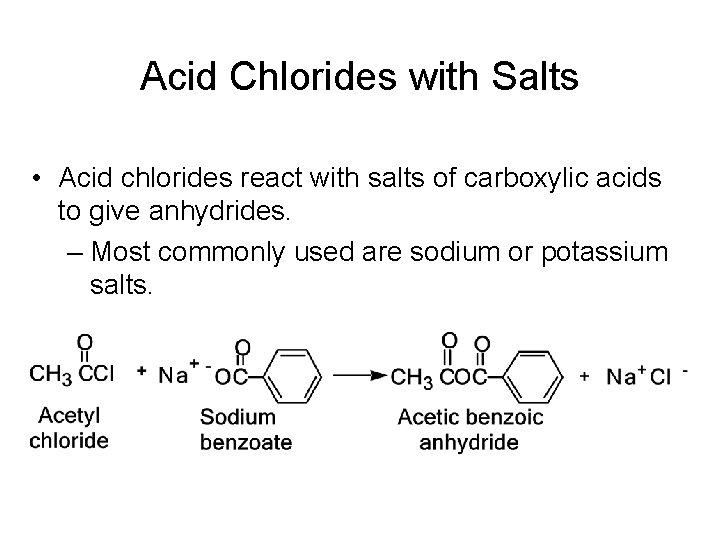
Acid Chlorides with Salts • Acid chlorides react with salts of carboxylic acids to give anhydrides. – Most commonly used are sodium or potassium salts.
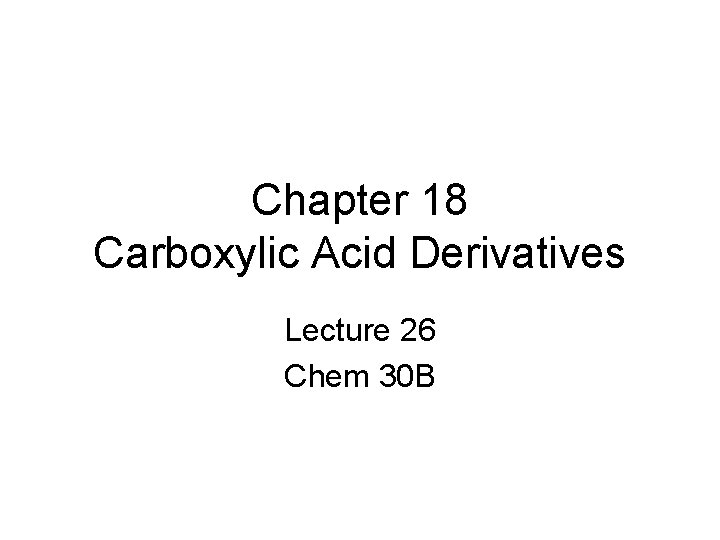
Chapter 18 Carboxylic Acid Derivatives Lecture 26 Chem 30 B
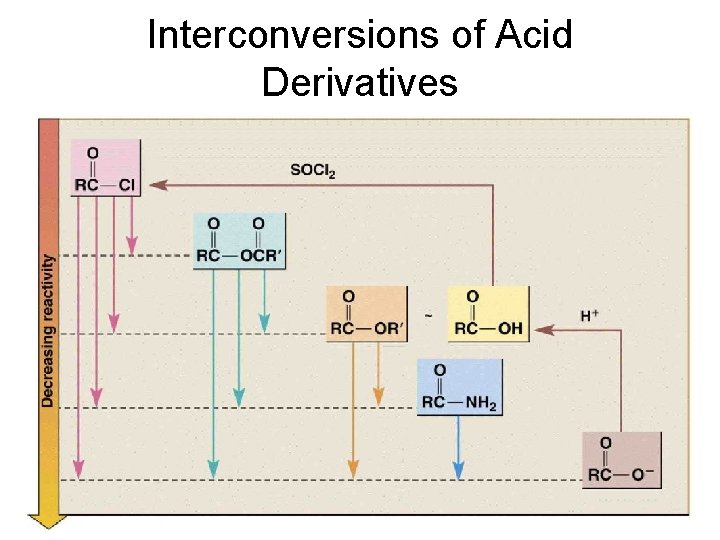
Interconversions of Acid Derivatives
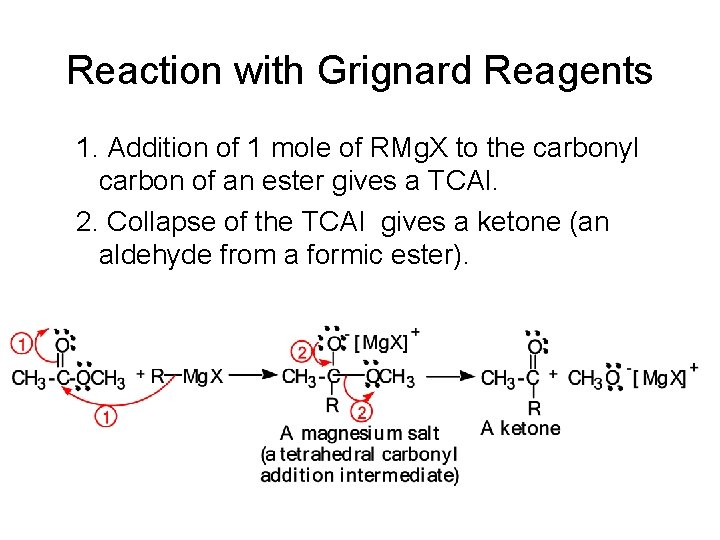
Reaction with Grignard Reagents 1. Addition of 1 mole of RMg. X to the carbonyl carbon of an ester gives a TCAI. 2. Collapse of the TCAI gives a ketone (an aldehyde from a formic ester).
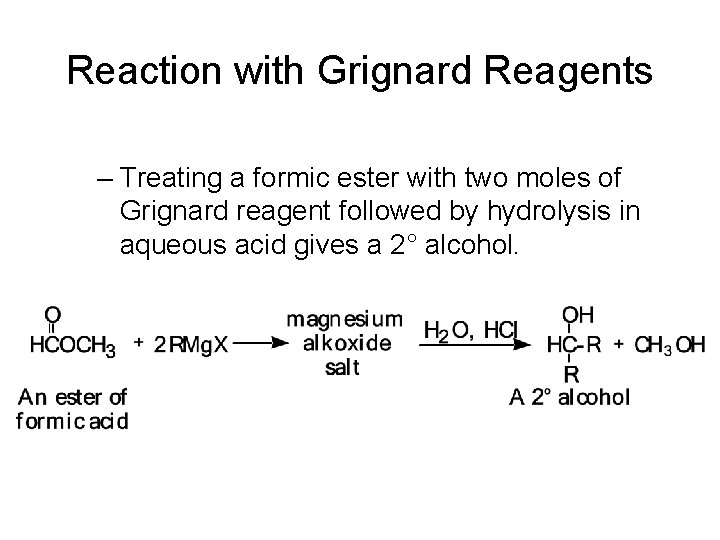
Reaction with Grignard Reagents – Treating a formic ester with two moles of Grignard reagent followed by hydrolysis in aqueous acid gives a 2° alcohol.
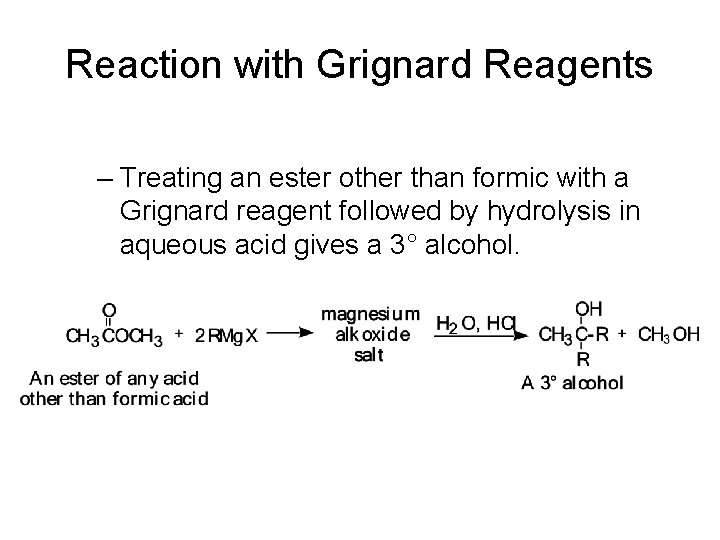
Reaction with Grignard Reagents – Treating an ester other than formic with a Grignard reagent followed by hydrolysis in aqueous acid gives a 3° alcohol.
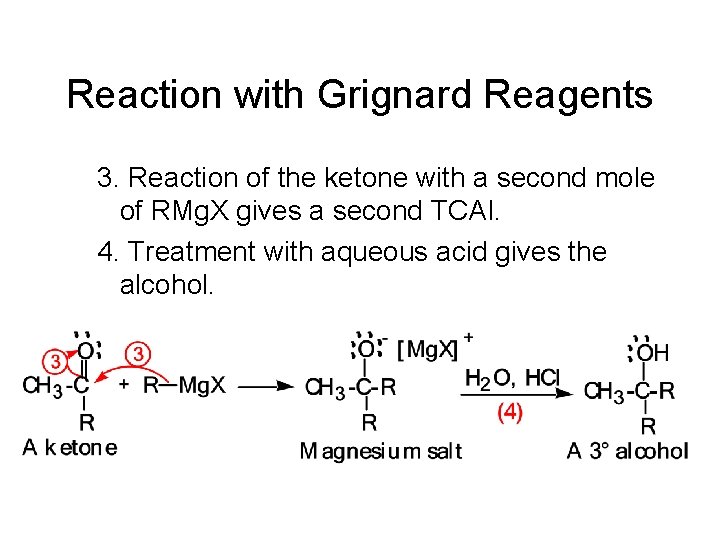
Reaction with Grignard Reagents 3. Reaction of the ketone with a second mole of RMg. X gives a second TCAI. 4. Treatment with aqueous acid gives the alcohol.

Reactions with RLi • Organolithium compounds are even more powerful nucleophiles than Grignard reagents. – They react with esters to give the same types of 2° and 3° alcohols as do Grignard reagents – and often in higher yields.
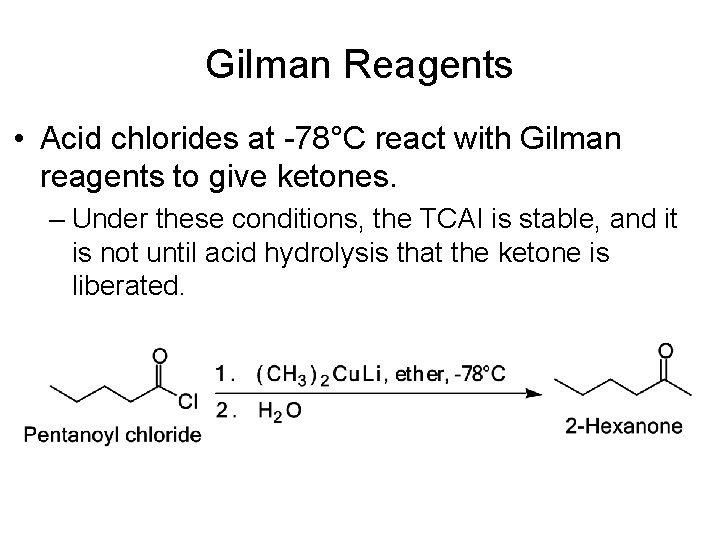
Gilman Reagents • Acid chlorides at -78°C react with Gilman reagents to give ketones. – Under these conditions, the TCAI is stable, and it is not until acid hydrolysis that the ketone is liberated.

Gilman Reagents – Gilman reagents react only with acid chlorides. – They do not react with acid anhydrides, esters, amides or nitriles under the conditions described.

Reduction - Esters by Li. Al. H 4 • Most reductions of carbonyl compounds now use hydride reducing agents. – Esters are reduced by Li. Al. H 4 to two alcohols. – The alcohol derived from the carbonyl group is primary.

Reduction - Esters by Li. Al. H 4 • Reduction occurs in three steps plus workup: – Steps 1 and 2 reduce the ester to an aldehyde. – Step 3: Reduction of the aldehyde followed by work-up gives a 1° alcohol derived from the carbonyl group.
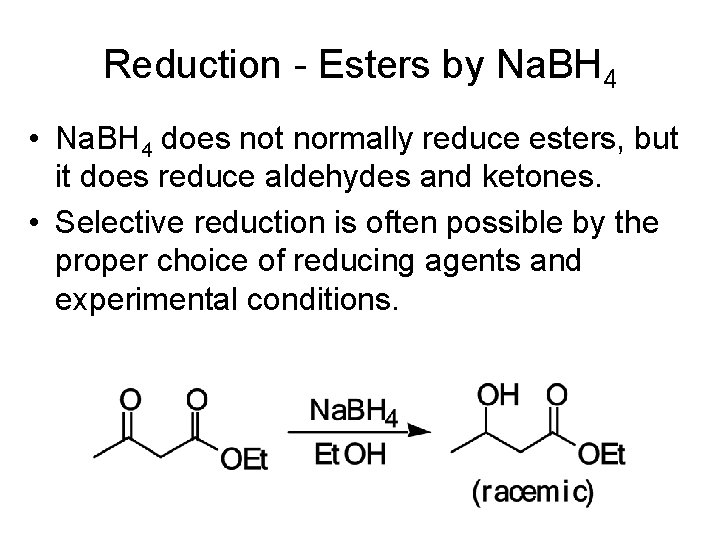
Reduction - Esters by Na. BH 4 • Na. BH 4 does not normally reduce esters, but it does reduce aldehydes and ketones. • Selective reduction is often possible by the proper choice of reducing agents and experimental conditions.
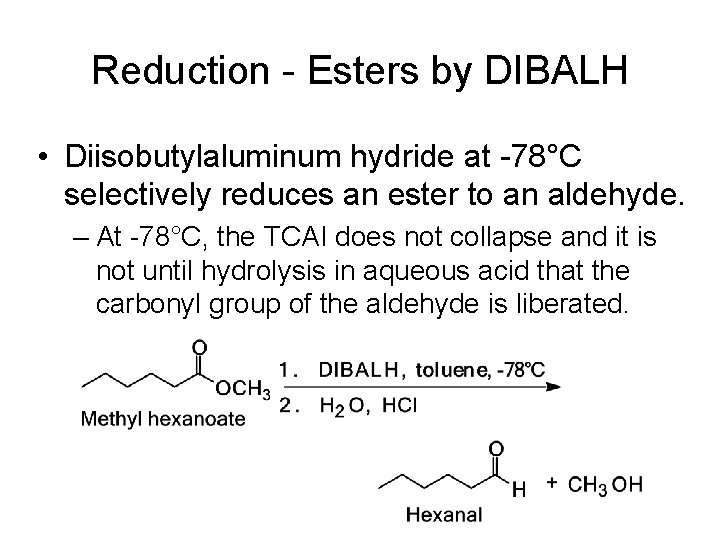
Reduction - Esters by DIBALH • Diisobutylaluminum hydride at -78°C selectively reduces an ester to an aldehyde. – At -78°C, the TCAI does not collapse and it is not until hydrolysis in aqueous acid that the carbonyl group of the aldehyde is liberated.

Reduction - Amides by Li. Al. H 4 • Li. Al. H 4 reduction of an amide gives a 1°, 2°, or 3° amine, depending on the degree of substitution of the amide.
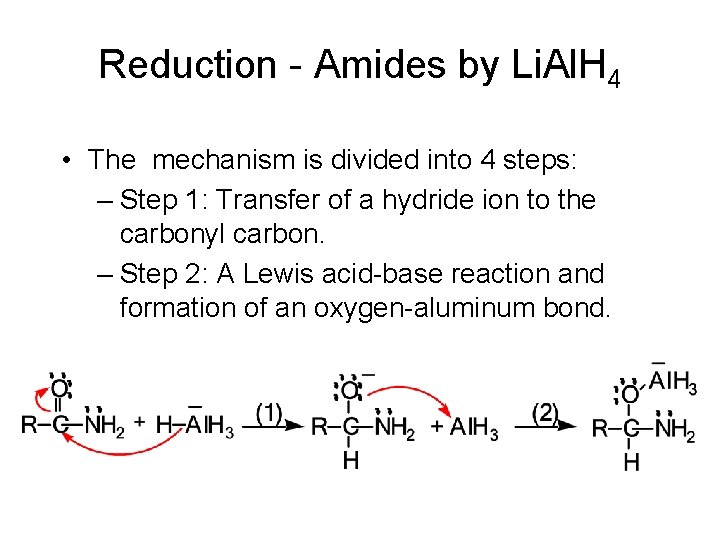
Reduction - Amides by Li. Al. H 4 • The mechanism is divided into 4 steps: – Step 1: Transfer of a hydride ion to the carbonyl carbon. – Step 2: A Lewis acid-base reaction and formation of an oxygen-aluminum bond.

Reduction - Amides by Li. Al. H 4 – Step 3: Redistribution of electrons and ejection of H 3 Al. O- gives an iminium ion. – Step 4: Transfer of a second hydride ion to the iminium ion completes the reduction to the amine.

Reduction - Nitriles by Li. Al. H 4 The cyano group of a nitrile is reduced by Li. Al. H 4 to a 1° amine.
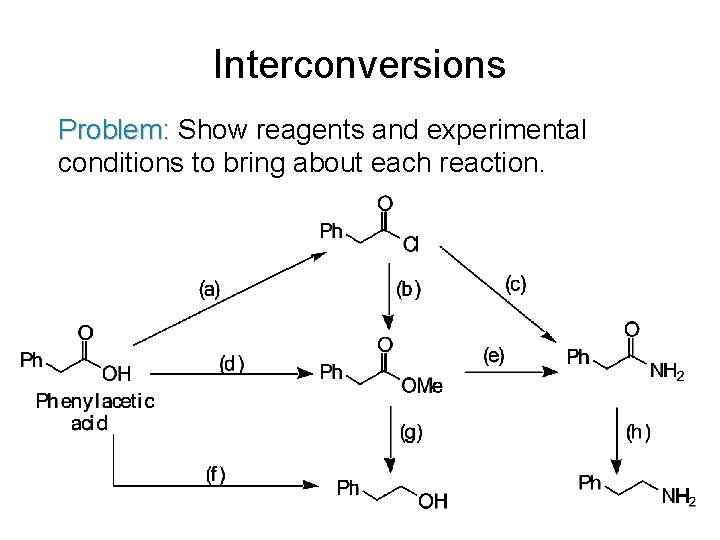
Interconversions Problem: Show reagents and experimental conditions to bring about each reaction.
- Slides: 66